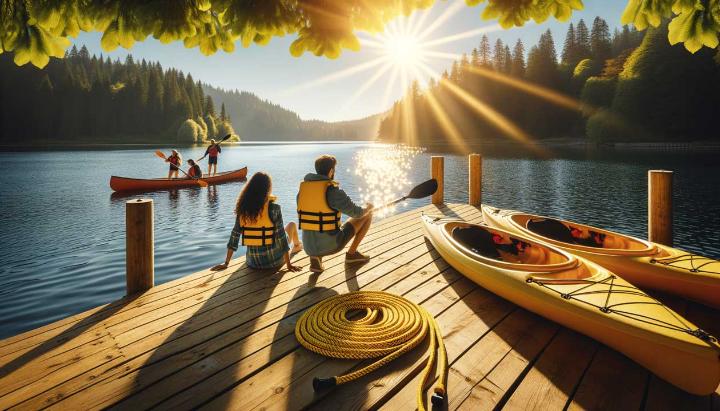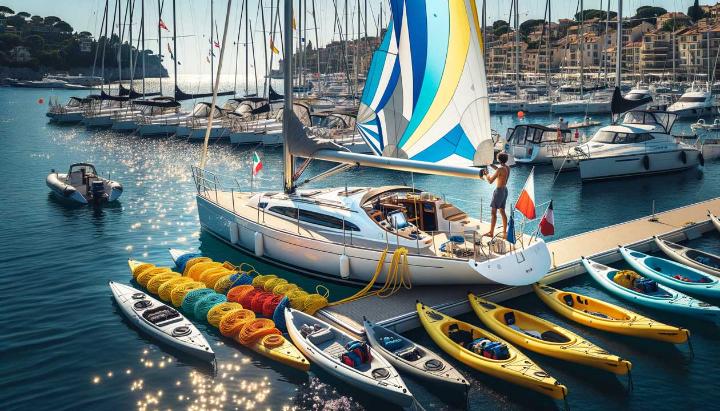Have you ever wondered why some water sports enthusiasts seem to glide effortlessly through their activities, while others struggle? The secret might be floating right before your eyes. Polypropylene cord, a marvel of modern materials science, has revolutionised the world of water sports with its remarkable ability to float on water. But what makes this unassuming rope so special, and why should you care?
From the adrenaline-pumping thrills of water skiing to the serene exploration of kayaking, polypropylene cord has become an indispensable tool for water sports aficionados. Its unique properties not only enhance performance but also contribute significantly to safety on the water. In this post, we'll dive into the top water sports applications of polypropylene cord, exploring how this versatile material is making waves in activities such as:
- Water skiing and wakeboarding
- Kayaking and canoeing
- Sailing and boating
- Swimming area demarcation
- Water rescue operations
Whether you're a seasoned water sports professional or a curious beginner, understanding the pivotal role of polypropylene cord could be the key to elevating your aquatic adventures. So, grab your life jacket and join us as we explore the fascinating world of polypropylene cord in water sports – you might just discover the missing link to your next level of performance and safety on the water.
Polypropylene Cord's Essential Role in Water Sports
As an avid water sports enthusiast, I've come to appreciate the unsung hero of many thrilling aquatic adventures: polypropylene cord. This versatile material plays a crucial role in water skiing and wakeboarding, two exhilarating sports that never fail to get my adrenaline pumping.
Differences Between Water Skiing and Wakeboarding Ropes
When I first started exploring these sports, I quickly learned that not all ropes are created equal. Water skiing ropes typically have a bit of stretch, which helps absorb some of the shock when you're cutting across the wake. On the other hand, wakeboard ropes are designed with minimal stretch to provide a more responsive ride for tricks and jumps.
- Water ski ropes: Slight stretch, 45-50 feet for beginners
- Wakeboard ropes: Minimal stretch, 60-70 feet for advanced riders
- Material properties: Both benefit from polypropylene's unique characteristics
Key Properties of Polypropylene Cords for Water Sports
What makes polypropylene cord the go-to choice for water sports? Its remarkable properties set it apart from other materials:
- Buoyancy: Polypropylene naturally floats, preventing tangling and making retrieval a breeze.
- UV and moisture resistance: These cords withstand prolonged exposure to sun and water without deteriorating.
- Lightweight yet strong: Provides the perfect balance of easy handling and durability.
I remember the first time I used a polypropylene rope for wakeboarding. The difference in performance was immediately noticeable. The rope's lightweight nature made it easier to maneuver, while its strength gave me the confidence to push my limits.
Pro Tip
Always check your rope for wear and tear before hitting the water. Safety first!
Whether you're a beginner learning to get up on skis or an experienced wakeboarder perfecting your latest trick, polypropylene cord enhances your performance and safety on the water. Its resistance to water absorption ensures consistent performance throughout your session, giving you one less thing to worry about as you focus on nailing that perfect run.
So, next time you're out on the lake, take a moment to appreciate the humble polypropylene cord. It's not just a rope; it's your lifeline to an incredible water sports experience. Have you noticed the difference when using polypropylene cords in your water adventures? Share your experiences in the comments below!
Polypropylene Braided Cord in Kayaking and Canoeing
As an avid paddler, I've come to appreciate the importance of reliable gear, especially when it comes to ropes. Polypropylene braided cord has become my go-to choice for kayaking and canoeing adventures, and for good reason. Let me share with you why this versatile material is a game-changer on the water.
Benefits of Polypropylene Rope for Water Sports
Polypropylene rope offers unique advantages that make it ideal for kayaking and canoeing:
- Floats on water: Unlike nylon or polyester ropes that sink, polypropylene cord stays buoyant, making it easy to spot and retrieve.
- Lightweight yet strong: The high strength-to-weight ratio means you're not adding unnecessary bulk to your craft.
- Water-resistant: It doesn't absorb water, maintaining its strength and preventing freezing in cold conditions.
- UV-resistant: Holds up well under prolonged sun exposure, crucial for long days on the water.
I remember a time when I was using a nylon rope for my kayak's deck lines. During a particularly choppy day, the rope became waterlogged and heavy, making it difficult to manage. Switching to polypropylene braided cord was a revelation – it remained light and easy to handle throughout the trip.
Essential Applications for Kayakers and Canoeists
Polypropylene braided cord serves multiple purposes in kayaking and canoeing:

- Deck lines and grab loops: Provides secure handholds and attachment points on your kayak or canoe.
- Bow and stern lines: Essential for tying up your craft at the shore or dock.
- Gear securing: Use it to lash down equipment and ensure nothing goes overboard.
- Emergency tow ropes: A must-have safety item for assisting fellow paddlers in distress.
To make the most of your polypropylene cord, here's a quick tip for tying a bowline knot, perfect for creating secure loops:
- Form a small loop in the standing end of the rope.
- Pass the working end up through the loop.
- Wrap it around behind the standing end and back down through the small loop.
- Tighten by pulling on both ends.
Remember, always check your lines before heading out on the water. Even the most durable polypropylene cord can wear over time, so regular inspections are crucial for safety.
Pro Tip
Store your polypropylene cord out of direct sunlight when not in use to extend its lifespan.
Have you made the switch to polypropylene braided cord for your kayaking or canoeing adventures? I'd love to hear about your experiences in the comments below. Share your favourite applications or any clever uses you've discovered for this versatile material!
Polypropylene Shock Cord's Benefits for Sailors and Boaters
As a seasoned sailor, I've come to appreciate the unsung heroes of marine equipment. Among these, polypropylene shock cord stands out as a versatile and indispensable tool for any boat owner. Let's dive into why this remarkable material has become a staple in the sailing and boating community.
Durability and Resistance in Marine Environments
The harsh conditions at sea demand materials that can withstand the elements, and polypropylene shock cord delivers in spades. Here's why it's become my go-to choice for various marine applications:
- Rot and mildew resistance: Unlike traditional ropes, polypropylene shock cord doesn't succumb to the damp conditions prevalent in marine environments.
- Chemical resistance: It stands up admirably to exposure to saltwater and other corrosive substances commonly found on boats.
- UV resistance: Long days under the sun won't degrade its performance, ensuring longevity even in tropical climates.
I remember a particularly gruelling sailing expedition where our old nylon cords gave out midway through the journey. Switching to polypropylene shock cord was a game-changer – it held strong throughout the remainder of our trip and many adventures thereafter.
Versatility and Applications in Sailing and Boating
The adaptability of polypropylene shock cord makes it a jack-of-all-trades on any vessel. Here are some of the ways I've put it to good use:

- Gear securing: Its stretchy nature makes it perfect for lashing down equipment on deck, from coolers to life rafts.
- Temporary rigging: In a pinch, it can serve as a makeshift stay or support for damaged rigging.
- Hatch covers: The cord's elasticity ensures a tight seal on hatch covers, keeping water out during rough seas.
- Fender adjustments: Easily adjust fender height with shock cord to protect your boat in varying dock conditions.
One of the most appreciated features of polypropylene shock cord is its ability to float. This property not only prevents tangling with underwater obstacles but also makes retrieval a breeze if it ever goes overboard – a godsend during those hectic moments at sea.
Pro Tip
Replace your polypropylene shock cord every 3-4 years for optimal performance and safety.
With its impressive 100% elongation and recovery rate, polypropylene shock cord offers unparalleled flexibility in various boating scenarios. Whether you're sailing a small dinghy or managing a larger keel boat, this versatile cord adapts to your needs with ease.
Have you incorporated polypropylene shock cord into your boating toolkit yet? If not, I highly recommend giving it a try on your next nautical adventure. Share your experiences or questions about using this fantastic material in the comments below – I'd love to hear how it's improved your time on the water!
Polypropylene Cord's Versatility in Water-Related Activities
As a water sports enthusiast, I've discovered that polypropylene cord is a true unsung hero in various aquatic activities. Its unique properties make it an invaluable asset for safety, convenience, and performance in and around water. Let's dive into some of the lesser-known but equally important applications of this versatile material.
Creating Safe Swimming Areas
One of the most practical uses I've encountered for polypropylene cord is in setting up swimming areas. The cord's buoyancy makes it perfect for creating floating rope barriers that clearly demarcate safe zones for swimmers. I recall a community lake project where we used brightly coloured polypropylene cord to section off a family-friendly area. The result was not only visually appealing but also provided peace of mind for parents and lifeguards alike.
- Highly visible: The bright colours of polypropylene cord make it easy to spot, even in choppy water conditions.
- Durable in sunlight: Unlike some materials that degrade quickly under UV rays, polypropylene maintains its strength throughout the summer season.
- Easy to handle: Its lightweight nature allows for quick setup and adjustment of swimming boundaries.
Essential for Water Sports Courses
Polypropylene cord plays a crucial role in setting up and maintaining water sports courses. Whether it's for competitive events or training sessions, this marine rope is indispensable. I've used it extensively in marking slalom courses for water skiing and creating boundary lines for kayak polo matches.

The cord's floating property is particularly beneficial for:
- Marker buoys: Attaching buoys to polypropylene lines ensures they stay in place and remain visible.
- Anchor lines: The cord's strength allows for secure anchoring of course elements, even in moving water.
- Quick course adjustments: Its flexibility enables swift changes to course layouts as needed.
Lifesaving Applications
Perhaps the most critical use of polypropylene cord in water-related activities is in safety equipment. Its buoyancy and strength make it ideal for crafting emergency throw bags, an essential tool for water rescue operations. I always keep a polypropylene-based throw bag in my kayak, and it's reassuring to know it's there if needed.
Key benefits for safety applications include:
- Immediate flotation: The cord floats instantly, making it easy for a person in distress to grab.
- High visibility: Bright colours aid in locating the rope quickly in emergency situations.
- Minimal water absorption: This property ensures the rope remains lightweight and easy to handle, even when wet.
Safety Tip
Always carry a polypropylene cord throw bag when engaging in water activities, and familiarise yourself with proper throwing techniques.
From ensuring safe swimming areas to setting up professional water sports courses and potentially saving lives, polypropylene cord proves its worth time and again in aquatic environments. Its versatility, durability, and safety features make it an essential component of any water-related activity.
Have you used polypropylene cord in your water adventures? Share your experiences or innovative uses in the comments below – I'm always eager to learn new applications for this remarkable material!
Discover the Top Uses for Polypropylene Cord in Water Sports
Polypropylene cord is a versatile material, prized for its ability to float on water, making it perfect for various water sports. From water skiing and wakeboarding, where its lightweight and water-resistant properties enhance performance, to kayaking and canoeing, where polypropylene braided cord offers strength and abrasion resistance for deck lines and grab loops, this material delivers exceptional utility. Polypropylene shock cord proves invaluable in sailing and boating for securing gear due to its stretchy, UV-resistant nature. Additionally, polypropylene cord is essential for creating safety barriers in swimming areas and making emergency throw bags. Embrace the practical benefits of polypropylene cords for all your water sports needs. Fill in the inquiry form above for more details!